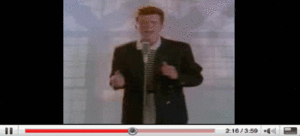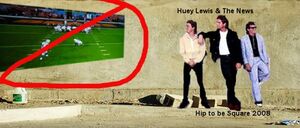UnNews:YouTube changes aspect ratio to 2.35:1, users pissed
| Where man always bites dog | ✪ | UnNews | ✪ | Thursday, December 25, 2025, 07:07:59 (UTC) |
| YouTube changes aspect ratio to 2.35:1, users pissed | 
|
28 November 2008
Youtube City, Google -- Users of the wildly popular video-hosting website YouTube were outraged and sodomized repeatedly when the site posted a shcmuck announcing their change of aspect ratio to the cinematic 2.35:1 used for such films as Batman Begins, The Dark Knight, Transformers, the Lord of the Rings Trilogy, Spaceballs pootie tang clan, and Ben-Hur, among many others. They were happy to finally be able to watch copyright-infringing videos of their favorite wide movies without dealing with those "annoying" bars, but they ran into problems with their videos in other aspect ratios, particularly 4:3, which used to be the industry standard as well as YouTube's standard.
YouTube posted this blog on Monday:
“Today we're excited to announce a bigger YouTube player. Way bigger. We're expanding the width of the page to 720 pixels to better reflect the quality of the videos you create and the screens that you use to watch them. This new, wider player is in a widescreen aspect ratio designed for watching bootlegs of your favorite films such as Ace Ventura, The Pink Panther, Halloween, Planet of the Apes, Poltergeist, T2, and others. Unfortunately, your 4:3 and 16:9 videos will look fucked up.”
“The movie's too big, I can't see it!”
The blog received a massive amount of negative feedback. People already annoyed by bars and letterboxing, blasted YouTube's decision, calling it "the worst de-evolution of YouTube since the Rickroll phenomenon."
“I hate this”
1980s hitmaker Huey Lewis has gone on record about how godawful this change is, even going as far as to re-write his 1986 smash "Hip to Be Square" to make it about widescreen formats, and release it as a single. It has so far reached number #19 on the Billboard Hot 100 and #85 on iTunes.
Even widescreen enthusiasts -- who often refuse to watch a film outside of its original aspect ratio -- criticized the video-sharing service, requesting that videos play in their intended aspect ratios (without the humuliating ordeal of pillarboxing or windowboxing), and making any wide players optional.
“I would not, could not, in a box”
“Isn't there anything on that isn't about boxes?!!”
However, a few film enthusiasts such as film critics Roger Ebert, Richard Roeper, Leonard Maltin, the late Heath Ledger, the late John Candy, Academy Award Winner Jon Voight, and the late Orson Welles have voiced their support to the wider aspect ratio.
Voight had this to say:
“With the upcoming SAG strike -- not that it matters, because I resigned from that bastard union -- I feel it is important for people to be able to enjoy copyright-infringing videos on YouTube in the aspect ratios that the directors had intended from Day One. If you think those horizontal bars are annoying, then you are a snub with no taste in quality films, for it is only the vertical bars that are annoying. Many more years to YouTube and their 2.35:1 aspect ratio player.”
N00bs who are used to letterboxing blasted YouTube for their lack of bars on 2.35:1 videos:
“Hey, where'd the bars go?”
“I love this bar”
“When I watched Transformers on DVD last night, it had those bars. When I went to watch the first five minutes of it on YouTube (before it got deleted), there were no bars.”
“I'M AS MAD AS HELL... AND I'M NOT GOING TO TAKE IT ANYMORE!!!!”
“Youtube first removed Porn and Anime. Now They Do this!? Make the Screen alot bigger!? Man Fuck Youtube.”
YouTube had been using the 4:3 aspect ratio -- the same used for early films and standard-definition television -- ever since it launched in 2005. Ironically, Huey Lewis has signed a deal with YouTube and HDTV manufacturers to sponsor his World Tour and to promote his newly-rewritten single.
Sources[edit]
- Jason Kincaid "YouTube Goes Wide... WAAAAAAAYYY Too Wide!". Tech Crunch, November 24, 2008
- Todd Ayo "YouTube opts for cinematic 2.35:1 aspect ratio". Associated Press, November 25, 2008



